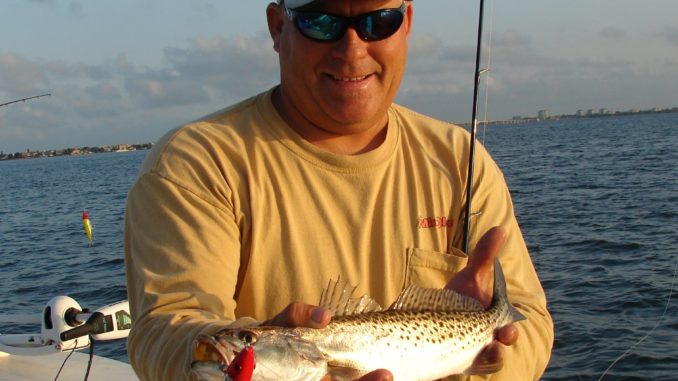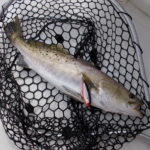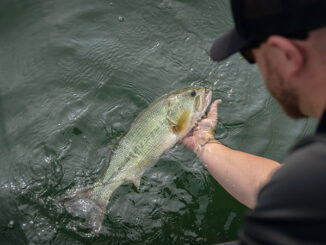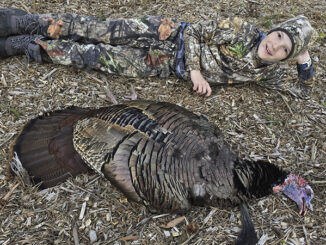
Sinking, floating or suspending, this time-tested line of baits can put more fish in your boat — if yo know how to use them.
Fish can be caught any number of ways, but MirrOlures hold a special place with a number of saltwater fishermen, especially those who spend time in inshore waters.
If anyone knows these lures, it’s Lee Parsons, a guide from Wilmington, N.C., who is often referred to be his peers as the “MirrOlure Guru.” He’s not only proficient in their use, but he’s got an innate knowledge that allows him to rattle off model numbers and colors better than most folks remember what they had for breakfast.
But as far as basics go, it’s a matter of picking the correct style and size of MirrOlure for the task at hand, be it speckled trout, redfish, Spanish mackerel or anything else with fins.
“The shape, size and weight are the important factors in choosing any lure, especially a MirrOlure,” Parsons said. “We’ve always heard to match the hatch, and it’s really that simple. The shape and size are used to match the bait the fish are feeding on at that particular time, and the weight gets it to the right level in the water column.
“Don’t get me wrong, color is important, too … but the size and shape will be recognized by the fish first,” Parsons said. “Once you’ve got that matched, you can worry about color. Sometimes, color doesn’t appear as important, and they will hit several colors. However, trout sometimes can get real finicky and only hit one color. I’ve even seen their preferred color change while I was fishing.”
One of Parsons’ favorite lures is the MirrOdine 17 or 27MR. The 17 size is for earlier in the year when baitfish are small, and the 27MR becomes a better option as the bait grows. He likes greens and golds in clear water; when the water is cloudy, he switches to a lure with silver sides that will flash and help the lure get noticed.
Early in the fall trout season, Parsons uses mainly the 52M and Catch 2000 models. When the fall mullet migration begins, he uses the Catch 2000 because it suspends in 3 feet or less water, which is usually where the mullet are and where the predators are stalking them. The Catch 2000 also casts a little farther, which can be helpful at times, especially when fish are skittish.
When the bait moves deeper, Parsons switches to the 52M or 52MR Series — the “R” designates a rattle in the body of the lure — which sink faster. The TT Series profile looks similar to the 52M Series, but it has a wider profile that helps it sink a little deeper when fished against a current.
How deep and fast will the lures sink, and how far should you let them sink before starting the retrieve? Parsons said every model, sinking or suspending, is different.
“A 52 sinks like a rock,” he said. “A 17 is a slow sinker. The best thing you can do is drop one down beside the boat and see what that particular lure does,” he said. “Or you can let out a couple of feet of line and stick your rod tip down in the water and see how fast the lure sinks.
Parsons also likes the L29MR MirrOlip, a lipped diving lure. with a rattle that dives to 5 or 6 feet. MirrOlure recently added the L30MR, a little smaller and a little lighter but with a larger lip. With it, Parsons said he has hit the bottom at 9 feet. One trick he uses a lot is to trail a L29MR behind his boat in the current. It will dive a little and swim very lazily unless the current is really strong. and it usually catches a fish or two on its own.
“Everyone likes catching fish on topwaters, and I’m no different,” Parsons said. “I stay with smaller lures, like the Catch Jr. and MirrOmullet when the water is calm. When the wind picks up and the water gets choppy, I switch to larger lures with a higher-pitched rattle, like the She Dog and She Pup. Sometimes the pitch of the rattle can be everything, so if what you’re throwing isn’t working, try changing that first.
“I don’t think color is all that important for topwaters,” Parsons said. “Fish will be looking up at it, and the belly will always be dark against the sky. The most-important thing about color with topwaters is that you can see it clearly to be sure you are walking it. If the line is tangled and it isn’t walking, it won’t catch, so you’re far better off to get it in, clear the tangle and make another cast.”
Parsons doesn’t fish MirrOlures for red drum except for topwaters. He said drum hit subsurface lures hard and suck them deep, which makes them difficult to release without injury.
“Red drum are lots of fun to catch on topwaters,” Parsons said. “Red drum have … to roll at least to their side to hit a surface bait. Usually you can see them rise and charge the bait as they turn on their side to strike it. You have to wait until you feel them to set the hook, and many times they miss and are snagged outside their mouth. Even when they get the lure in their mouth, they usually only get one hook and are fairly easy to release.”
Parsons said he has seen several trout swim past a bait and slap it with their tail to stun it before eating it, so when you have a missed strike, pause or move the lure very slowly, like it is stunned, and the trout may come back.
Parson likes to tie MirrOlures on using a small loop, as it gives lures the most-realistic action. His grandfather taught him the loop; he said it closely resembles the No-Slip Loop Knot .
Mark Dickson of Shallow Minded Inshore Charters in North Myrtle Beach, S.C., uses MirrOlures the same ways that Parsons does, but also in several ways — and for several species — that might be considered unconventional.
“We have good populations of ladyfish in several locations, plus, there are usually good schools of bluefish, Spanish mackerel and more just outside the (Little River) jetties,” said Dickson (843-458-3055). “One of my favorite things is to get these fish fired up and let the fishermen have at it. All of these fish are feeding on a mixture of shrimp, mullet minnows and peanut menhaden, and the action can be non-stop. We simply match the hatch for what they’re feeding on, and there are MirrOlures in just the right sizes, shapes and colors, regardless of the time of the year.”
Dickson positions his boat so he can cast upcurrent of riprap and docks that hold ladyfish. The MirrOlure Lumo Series, of with the smaller 14MR and 17 MR MirrOdines in the shape of a small menhaden, and the 9MR and 19 MR MirrOglass and MirrOminnow in slender, minnow shapes rarely make a pass through feeding ladyfish unscathed. Often the smaller sizes are better, but almost any size is fair game.
Another option for Dixon is to fill his baitwell full of small menhaden and anchor off the end of one of the jetties. He’ll thump a few menhaden on the boat’s deck to stun them, then throw them over the side. If there are any predators close by, it won’t be long before they are making small explosions in the water as they attack and eat the stunned baitfish.
“Once we get the area chummed up a little with all the live baits, the feeding fish get really aggressive,” Dickson said. “They strike with abandon and will pile onto the smaller 14 and 17 size Lumo Series MirrOdines. When baits are larger in the fall, they’ll hit the 27 size, too.”
Monofilament or fluorocarbon leaders are fine for ladyfish, bonito and false albacore, but they don’t stand a chance with the sharp teeth of bluefish and Spanish mackerel. Dickson uses a short piece of 11- or 17-pound Surflon Micro Ultra 19-strand soft wire when these toothy critters are around. to make a leader for the toothy critters. This isn’t one of the primary uses for MirrOlures, but MirrOdines, but they’re the perfect shape and do a lot of the work themselves, naturally suspending in the strike zone, with an occasional twitch that creates action the feeding fish can’t resist.
Tip: When it comes to picking colors for MirrOlures, Lee Parsons said it’s often a matter of matching the color of baitfish, but of picking a color that can be easily seen in the water you’re fishing. Variations in the color or stain of water you might be fishing are common. But don’t confuse color and stain. Many coastal rivers have dark, tannin-stained waters, but they’re clear. Ask “How far down can you see the lure?” when you drop it in the water. It’s clear if you can see the lure 4 to 5 feet deep. In water that’s stained, visibility can be less than a foot.









Be the first to comment